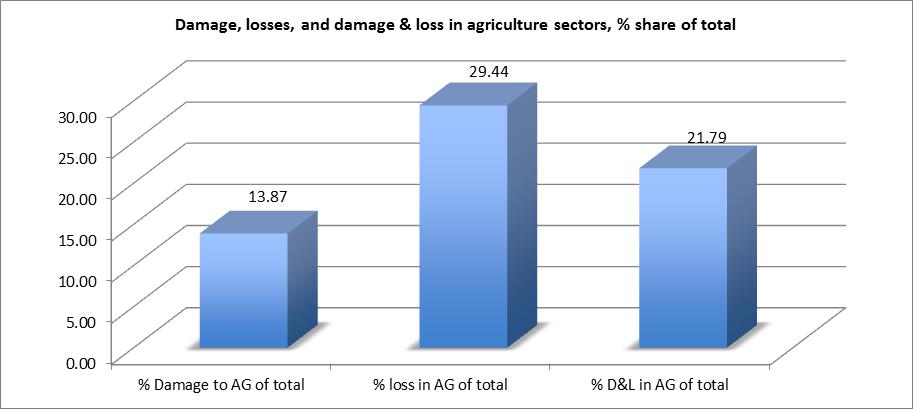
An FAO study conducted in 2013 assessed the level of disaster risk reduction (DRR) mainstreaming in the agriculture sector in 30 high-risk countries. Nearly half include DRR in their agricultural sector development plans, strategies and policies — a positive development which represent progress. Yet the DRR content in these plans is often ad hoc and unstructured, and additional support is needed to bring all countries up to speed in best approaches to incorporating DRR into agriculture planning. Few countries have capacities and budget to support specific DRR agriculture sector planning— capacity and implementation of DDR activities at the local level is particularly weak. Still, great strides have been made in risk monitoring & early warning related to emergency preparedness measures for crop, livestock, fisheries in order to withstand natural hazards, and for food chain threats such as transboundary plant pests and animal diseases (i.e. locusts, avian flu).
Preliminary findings from an on-going FAO study in 30 countries show that natural disasters have a high impact on the agriculture sector (AG). Between 2003 and 2013 about 22% of the total impact of large scale disasters fell on the agriculture sector. Of this, 42% was on crops, 36% on livestock, 6% on fisheries, and 2.4% on forestry.
FAO experts participating in the World Conference on Disaster Risk Reduction:
Name: Mr. Dominique Burgeon
Position/Expertise: Strategic Objective Coordinator for Resilience and Senior Focal Person for UNISDR
Languages: English, French
Name: Mr. Mbuli Charles Boliko
Position/Expertise: Director, FAO Liaison Office in Japan
Languages: English, French
Name: Mr. Stephan Baas
Position/Expertise: Natural Hazards Main Area of Work Delivery Manager, UNISDR Focal Person and Technical Officer, Natural Resource and Climate Change Division.
Languages: English, German
Media contact:
Name: Mr. George Kourous, FAO Media Relations Officer
Email: george.kourous@fao.org
Tel: (+39) 06.570.53168
Mobile: (+39) 348.141.6802
Skype: g_kourous
The Food and Agriculture Organization of the United Nations (FAO) has long been committed to address DRR as a crucial element of its wider mandate of eradicating hunger, alleviating poverty, and promoting the sustainable use of natural resources. DDR is a key component in our efforts to build the resilience of the most vulnerable, in particular farmers, herders, foresters, fishers and other communities at risk. This commitment was further enhanced in 2013 when FAO identified increasing the resilience of livelihoods to threats and crisis affecting agriculture, food and nutrition as one of five key strategic objectives guiding our work. Structured in line with the priorities set out in the Hyogo Framework for Action, FAO’s “Resilient livelihoods” publication on Disaster Risk Reduction for agriculture and food and nutrition security provides strategic direction for countries frequently exposed to natural hazards. During 2014, FAO supported 75 vulnerable countries in increasing their resilience to natural hazards and extreme climate events. Policy advice and technical assistance for disaster risk reduction and management included technology transfer, training and capacity-development, the establishment of disaster risk monitoring & early warning systems, vulnerability assessments and sustainable ecosystem management for fisheries, forestry and other agriculture sectors. FAO’s work in partnership with many humanitarian and development actors and supports the UN Plan of Action on Disaster Risk Reduction for Resilience.